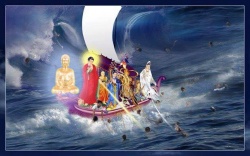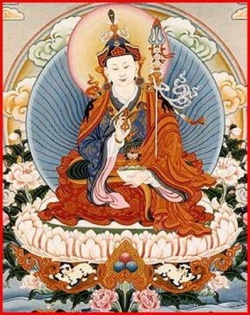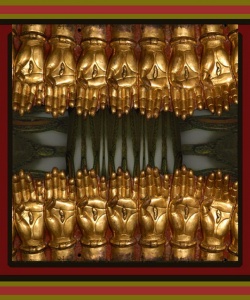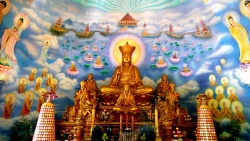Difference between revisions of "Panchikarana"
(Created page with " Panchikarana is the {{Wiki|Vedantic}} {{Wiki|theory}} of how {{Wiki|matter}} came into existent originating from the primordial five subtle elements. It is...") |
|||
| Line 1: | Line 1: | ||
| + | <nomobile>{{DisplayImages|4053|3081|1456|809}}</nomobile> | ||
| − | |||
| − | |||
| − | + | [[Panchikarana]] is the {{Wiki|Vedantic}} {{Wiki|theory}} of how {{Wiki|matter}} came into [[existent]] originating from the [[primordial]] [[five subtle elements]]. | |
| − | + | It is the method and process of the [[subtle matter]] (or the prior stage of {{Wiki|matter}}) to [[transform]] itself into gross {{Wiki|matter}}. | |
| − | The diverse [[characteristics]] of the creatures originate from Me alone – said Lord [[Krishna]] to {{Wiki|Arjuna}} ([[Wikipedia:Bhagavad Gita|Bhagavad Gita]] X.5). The {{Wiki|Vedic}} texts do not mention any order of creation but they do declare that [[Brahman]] being mere [[Existence]] cannot originate from itself, nor can [[Brahman]] be derived from a particular [[form]] of [[Existence]], and nor can [[Brahman]] come out of [[non-existence]] ([[Chandogya Upanishad]] VI.ii.2)( | + | [[Intelligence]] is the [[subtle manifestation of consciousness]] and {{Wiki|matter}} its gross [[manifestation]]. |
| + | |||
| + | [[Adi Shankara]] wrote a treatise on this {{Wiki|theory}}, titled – [[Panchikaranam]], which was elaborated by his [[disciple]] [[Sureshvaracharya]], and later on commented upon in 2400 [[slokas]] by [[Ramananda Saraswati]], [[disciple]] of [[Ramabhadra]], and in 160 [[slokas]] by [[Ananda Giri]], [[disciple]] of [[Suddhananda Yati]]. | ||
| + | |||
| + | |||
| + | The [[Chandogya Upanishad]] teaches the [[Doctrine of Trivirtkarana]], later borrowed by the [[Samkhya]] [[philosophy]], from which developed the [[Vedantic Theory of Panchikarana]] with regard to the creation of the [[transformed]] evolutes of the original [[elements]]. | ||
| + | |||
| + | This {{Wiki|theory}} is also found narrated to [[Narada]] in the [[Srimad Devi Bhagavatam]]. | ||
| + | |||
| + | |||
| + | [[Panchikarana]] is based on the assumed quintuplication of the basic/primordial [[five subtle elements]], the [[Panchbhootas]]. | ||
| + | |||
| + | The {{Wiki|Vedic}} seers believed that the [[Panchbhootas]] firstly divided themselves in two parts one part of which was further divided into [[four parts]], which 1/8th parts of each {{Wiki|subtle}} [[element]] then combined with other halves. | ||
| + | |||
| + | It was also assumed that this process of [[division]] and combination goes on till the gross [[elements]] are produced as a continuous unending process. | ||
| + | |||
| + | They believed that at the very beginning of creation [[Mahat]], on account of {{Wiki|disturbance}} of the [[three gunas]], gave rise to [[Ahamkara]] from which were produced in their {{Wiki|subtle}} states [[Akasa]], {{Wiki|Vayu}}, [[Agni]], [[Apah]] and [[Prithvi]].(seven stages). | ||
| + | |||
| + | |||
| + | Primary creation took place in three parts, | ||
| + | |||
| + | |||
| + | <poem> | ||
| + | a) Creation of [[Mahat]], | ||
| + | 2) Creation of [[Tanmatras]] ([[Bhoota sarga]]) and | ||
| + | 3) Creation of [[Indriyas]] ([[Vaikarika sarga]]). | ||
| + | </poem> | ||
| + | |||
| + | |||
| + | For {{Wiki|purpose}} of creation [[Brahman]] divided itself into [[Prakrti]], the combination of [[three gunas]], the [[word]] also meaning before creation or primary factor/female [[form]] for creation, and representing {{Wiki|matter}}, and [[Purusa]] ([[spirit]]), | ||
| + | |||
| + | the {{Wiki|male}} factor that has no [[tanmatras]] ([[subtle elements]]) [[attached]] to it. | ||
| + | |||
| + | |||
| + | They also believed that the process of [[Srishti]] ("creation"), [[Stithi]] ("[[sustenance]]") and [[Samhara]] ("dissolution") continues without any change or interruption. | ||
| + | |||
| + | |||
| + | |||
| + | [[Panchikarana]] involves one half of the original [[subtle element]] to be mixed up with 1/8th part each of the other original [[subtle elements]] to produce the [[gross element]] of the [[subtle element]] contributing its [[own]] one half. | ||
| + | |||
| + | When [[gross elements]] are produced then [[consciousness]] enters into these [[elements]] as their presiding [[deities]], then comes the [[feeling]] of [[egoism]] (I-ness) identifying with the [[body]]. | ||
| + | |||
| + | [[Gross elements]] solidify and assume [[forms]] as per their fundamental qualities. | ||
| + | |||
| + | |||
| + | The diverse [[characteristics]] of the creatures originate from Me alone – said Lord [[Krishna]] to {{Wiki|Arjuna}} ([[Wikipedia:Bhagavad Gita|Bhagavad Gita]] X.5). | ||
| + | |||
| + | The {{Wiki|Vedic}} texts do not mention any order of creation but they do declare that [[Brahman]] being mere [[Existence]] cannot originate from itself, nor can [[Brahman]] be derived from a particular [[form]] of [[Existence]], and nor can [[Brahman]] come out of [[non-existence]] ([[Chandogya Upanishad]] VI.ii.2)([[Shvetashvatara Upanishad]] VI.9) | ||
| + | |||
| + | even though from [[Brahman]] arises [[Vital force]] ([[Mundaka Upanishad]] II.i.3) and were born [[space]] and the rest [[primary elements]] ([[Taittiriya Upanishad]] II.i.1). | ||
| + | {{R}} | ||
| + | {{SanskritTerminology}} | ||
| + | [[Category:Buddhist Philosophy]] | ||
Latest revision as of 21:16, 8 December 2015
Panchikarana is the Vedantic theory of how matter came into existent originating from the primordial five subtle elements.
It is the method and process of the subtle matter (or the prior stage of matter) to transform itself into gross matter.
Intelligence is the subtle manifestation of consciousness and matter its gross manifestation.
Adi Shankara wrote a treatise on this theory, titled – Panchikaranam, which was elaborated by his disciple Sureshvaracharya, and later on commented upon in 2400 slokas by Ramananda Saraswati, disciple of Ramabhadra, and in 160 slokas by Ananda Giri, disciple of Suddhananda Yati.
The Chandogya Upanishad teaches the Doctrine of Trivirtkarana, later borrowed by the Samkhya philosophy, from which developed the Vedantic Theory of Panchikarana with regard to the creation of the transformed evolutes of the original elements.
This theory is also found narrated to Narada in the Srimad Devi Bhagavatam.
Panchikarana is based on the assumed quintuplication of the basic/primordial five subtle elements, the Panchbhootas.
The Vedic seers believed that the Panchbhootas firstly divided themselves in two parts one part of which was further divided into four parts, which 1/8th parts of each subtle element then combined with other halves.
It was also assumed that this process of division and combination goes on till the gross elements are produced as a continuous unending process.
They believed that at the very beginning of creation Mahat, on account of disturbance of the three gunas, gave rise to Ahamkara from which were produced in their subtle states Akasa, Vayu, Agni, Apah and Prithvi.(seven stages).
Primary creation took place in three parts,
a) Creation of Mahat,
2) Creation of Tanmatras (Bhoota sarga) and
3) Creation of Indriyas (Vaikarika sarga).
For purpose of creation Brahman divided itself into Prakrti, the combination of three gunas, the word also meaning before creation or primary factor/female form for creation, and representing matter, and Purusa (spirit),
the male factor that has no tanmatras (subtle elements) attached to it.
They also believed that the process of Srishti ("creation"), Stithi ("sustenance") and Samhara ("dissolution") continues without any change or interruption.
Panchikarana involves one half of the original subtle element to be mixed up with 1/8th part each of the other original subtle elements to produce the gross element of the subtle element contributing its own one half.
When gross elements are produced then consciousness enters into these elements as their presiding deities, then comes the feeling of egoism (I-ness) identifying with the body.
Gross elements solidify and assume forms as per their fundamental qualities.
The diverse characteristics of the creatures originate from Me alone – said Lord Krishna to Arjuna (Bhagavad Gita X.5).
The Vedic texts do not mention any order of creation but they do declare that Brahman being mere Existence cannot originate from itself, nor can Brahman be derived from a particular form of Existence, and nor can Brahman come out of non-existence (Chandogya Upanishad VI.ii.2)(Shvetashvatara Upanishad VI.9)
even though from Brahman arises Vital force (Mundaka Upanishad II.i.3) and were born space and the rest primary elements (Taittiriya Upanishad II.i.1).



